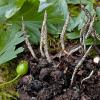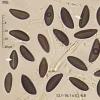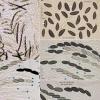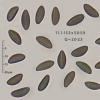
21-12-2025 09:32
Hello.A tiny ascomycete found embedded in wood in

21-12-2025 21:32
Pol DebaenstHello, Garden, Burgweg 19, Veurne, BelgiumOn 10/1

22-12-2025 23:38
Patrice TANCHAUDBonsoir, récolte sur un mur en pierre, apothéci

22-12-2025 00:47
Patrice TANCHAUDBonsoir, récolte à proximité du milieu dunaire

21-12-2025 21:40
Isabelle CharissouBonjour, j'aimerais connaitre les références de

20-12-2025 23:08
Patrice TANCHAUDBonsoir, récolte sur sol sablonneux dans l'arri�
Hi to everybody and specially Jacques Fournier
Today we have examined these gregarious stromata up to 40 mm high growing on buried seeds of Cornus sanguinea or Crataegus monogyna. We don't know what the host is because they are living together and the stromata were growing under both trees.
After reading wonderfull Fournier's keys we are observing that our ascospores are greater: 12-16 x 5-7 versus 11-13 x 4.6-5.9 sec. Jacques. Also we have seen that collections on Cornus seeds can be greater. The question is: There is some innovation on this matter?
Many thanks in advance

your observations are very interesting and strongly suggest that the Xylaria on Cornus fruits has larger ascospores than the one on Crataegus, as previously observed on the material collected by Peter Welt. I hope that will be sorted out on molecular grounds but it can be expected these fruit-inhabiting species are phylogenetically very closely related (see also X. delitschii). I have no new information so far.
Saludos,
Jacques
HI Jacques
Welcome from the Antillas. I wish that you have found nice fungi.
Well, we will analyze both collections and I will keep you informed.
Thanks a lot, jacques



